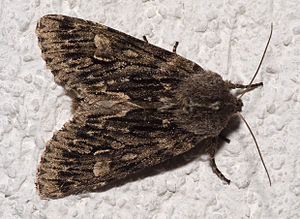Spring wire-haired owl
| Spring wire-haired owl | ||||||||||||
|---|---|---|---|---|---|---|---|---|---|---|---|---|

Spring wire-haired owl ( Brachionycha nubeculosa ) |
||||||||||||
| Systematics | ||||||||||||
|
||||||||||||
| Scientific name | ||||||||||||
| Brachionycha nubeculosa | ||||||||||||
| ( Esper , 1785) |
The spring wire-haired owl ( Brachionycha nubeculosa ) is a butterfly ( moth ) from the family of the owl butterflies (Noctuidae).
features
butterfly
The wingspan is about 45 to 60 millimeters. The color of the forewings is quite variable across the entire range of the species. However, individual populations can be fairly constant in color and pattern. The color varies from dark ash-gray to brown-gray, each with black intermingling and large black-rimmed blemishes. The transverse lines are toothed black and often indistinct. Small black triangular spots can be seen at the seam between the veins . The hind wings are brown-gray with a dark central spot. The following forms are described:
- f. grisescens with light gray fore wings
- f. perfumosa with blackish dark brown fore wings
The proboscis of the moths is stunted.
Egg, caterpillar and pupa
The egg is spherical, flattened at the base and weakly ribbed. It is dark red-brown with blue-gray points. The caterpillars are green and have a yellow, often interrupted topline. Each segment has small yellow warts on the sides. On the side of the third segment there is a thick, yellow slash, which is bordered in reddish, similar slashes are on the last, bump-like segment. The white stigmas are darkly lined. The head is light green. The doll is leathery, with a long, stick-shaped cremaster ending in two points .
distribution and habitat
The distribution area of the species extends from the British Isles in the west, across central and northern Europe to Russia, Siberia and China. The species is only locally distributed in Central Europe, but is often relatively common in this region. In southern Europe the occurrence is limited to a few mountain regions. In Germany it occurs up to the summit regions of the low mountain range. The species is moisture-loving and prefers moist, cool, temperate forests, mixed forests , wooded valleys, river and stream edges and orchards.
Phenology and way of life
The species forms one generation per year. As one of the first owl species of the year, the moths occasionally appear in February, the main flight time is in March and April. The moths are good fliers and nocturnal. They are attracted by artificial light sources . Despite the stunted proboscis, the moths can be observed sucking tree sap, and occasionally they even come to bait . However, other authors contradict this observation. In early spring they can be found sitting quietly on the trunks of forest trees during the day.
The eggs are (at least in captivity) laid individually on the branches of very different deciduous trees and shrubs.
The caterpillars live in May and June. They feed on the leaves of alder , birch , linden , European beech , hornbeam , elm , willow , poplar , plum and sloe . They hide during the day and feed at night. Pupation takes place in a cocoon that is relatively deep in the earth. Under breeding conditions, the caterpillar buried itself up to 20 cm deep. The pupa overwinters, it can also survive a winter.
Systematics
The species was first scientifically described in 1785 by Eugen Johann Christoph Esper as Bombyx nubeculosa . In 1787 the species was described again and this time under Noctua centrolinea by Johann Christian Fabricius ; a further description followed in 1924 under the name Brachyonycha eugraphomena by Hermann Stauder . These names are more recent synonyms of Brachionycha nubeculosa (Esper, 1785). Brachionycha nubeculosa is also the type species of the genus Brachionycha Hübner, 1815. Currently, apart from the nominate subspecies, two subspecies are distinguished:
- Brachionycha nubeculosa jezoensis Matsumura, 1928 (Japan)
- Brachionycha nubeculosa amurensis Draudt, 1934 (Amur region, Russia, China)
Hazard and protection
While the species is still common in Baden-Württemberg and Bavaria and is not classified as endangered, in North Rhine-Westphalia it is even considered threatened with extinction (Category 1). In Mecklenburg-Western Pomerania, Lower Saxony, Rheinpfalz, Saxony, Saxony-Anhalt and Thuringia it is classified as severely endangered (category 2), in Brandenburg only as endangered (category 3).
swell
literature
- Günter Ebert (Hrsg.): The Butterflies of Baden-Württemberg Volume 6, Nachtfalter IV. Ulmer Verlag Stuttgart 1997 (Eulen (Noctuidae) 2nd part), ISBN 3-8001-3482-9
- Walter Forster , Theodor A. Wohlfahrt : The butterflies of Central Europe. Volume 4: Owls. (Noctuidae). Franckh'sche Verlagshandlung, Stuttgart 1971, ISBN 3-440-03752-5 .
- Manfred Koch : We determine butterflies. Volume 3: Owls. 2nd, expanded edition. Neumann, Leipzig / Radebeul 1972, DNB 760072930 .
- Gábor Ronkay, Lázló Ronkay: Cuculliinae II. - Noctuidae Europaeae, Volume 7. , Sorø, 1995, ISBN 87-89430-04-2
Individual evidence
- ↑ a b Ronkay & Ronkay, p. 213
- ↑ a b c Manfred Koch: We determine butterflies. Volume 3: Owls. 2nd, expanded edition. Neumann, Leipzig / Radebeul 1972, DNB 760072930 .
- ^ A b Walter Forster, Theodor A. Wohlfahrt: The butterflies of Central Europe. Volume 4: Owls. (Noctuidae). Franckh'sche Verlagshandlung, Stuttgart 1971, ISBN 3-440-03752-5 .
- ↑ Red Lists of the FRG
Web links
- www.lepiforum.de Taxonomy and photos
- Moths and Butterflies of Europe and North Africa (English)
- Ian Kimber: Guide to the moths of Great Britain and Ireland (English)
- Brachionycha nubeculosa in Fauna Europaea
- Occurrence and endangerment in Germany